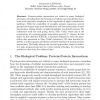BMCBI
2010
2010
Discover Protein Complexes in Protein-Protein Interaction Networks Using Parametric Local Modularity
13 years 11 months ago
Background: Recent advances in proteomic technologies have enabled us to create detailed protein-protein interaction maps in multiple species and in both normal and diseased cells...
BMCBI
2007
13 years 11 months ago
2007
Background: Although the prediction of protein-protein interactions has been extensively investigated for yeast, few such datasets exist for the far larger proteome in human. Furt...
BMCBI
2007
13 years 11 months ago
2007
Background: The systematic analysis of protein-protein interactions can enable a better understanding of cellular organization, processes and functions. Functional modules can be ...
BMCBI
2007
13 years 11 months ago
2007
Background: Protein-protein interactions are critical for cellular functions. Recently developed computational approaches for predicting protein-protein interactions utilize co-ev...
BMCBI
2010
13 years 11 months ago
2010
Background: Biological processes in cells are carried out by means of protein-protein interactions. Determining whether a pair of proteins interacts by wet-lab experiments is reso...
BMCBI
2010
13 years 11 months ago
2010
Background: Protein-protein docking for proteins with large conformational changes was analyzed by using interaction fingerprints, one of the scales for measuring similarities amo...
BMCBI
2010
13 years 11 months ago
2010
Background: High-throughput methods for detecting protein-protein interactions enable us to obtain large interaction networks, and also allow us to computationally identify the as...
BMCBI
2010
13 years 11 months ago
2010
Background: Systems biologists are faced with the difficultly of analyzing results from large-scale studies that profile the activity of many genes, RNAs and proteins, applied in ...
BMCBI
2010
13 years 11 months ago
2010
Background: Protein-protein interactions are fundamental for the majority of cellular processes and their study is of enormous biotechnological and therapeutic interest. In recent...
JOBIM
2000
14 years 3 months ago
2000
Protein-protein interactions are critical to many biological processes, extending from the formation of cellular macromolecular structures and enzymatic complexes to the regulation...



